|
|
|
Sort Order |
|
|
|
Items / Page
|
|
|
|
|
|
|
| Srl | Item |
| 1 |
ID:
175117


|
|
|
|
|
| Summary/Abstract |
Under the banner of martial empiricism, we advance a distinctive set of theoretical and methodological commitments for the study of war. Previous efforts to wrestle with this most recalcitrant of phenomena have sought to ground research upon primary definitions or foundational ontologies of war. By contrast, we propose to embrace war’s incessant becoming, making its creativity, mutability and polyvalence central to our enquiry. Leaving behind the interminable quest for its essence, we embrace war as mystery. We draw on a tradition of radical empiricism to devise a conceptual and contextual mode of enquiry that can follow the processes and operations of war wherever they lead us. Moving beyond the instrumental appropriations of strategic thought and the normative strictures typical of critical approaches, martial empiricism calls for an unbounded investigation into the emergent and generative character of war. Framing the accompanying special issue, we outline three domains around which to orient future research: mobilization, design and encounter. Martial empiricism is no idle exercise in philosophical speculation. It holds the promise of a research agenda apposite to the task of fully contending with the momentous possibilities and dangers of war in our time.
|
|
|
|
|
|
|
|
|
|
|
|
|
|
|
|
| 2 |
ID:
137827
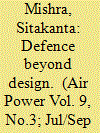

|
|
|
|
|
| Summary/Abstract |
The realm of ‘nuclear technology’ is amongst the most beguiling subjects of the human civilisation for the fact that words like ‘atom’ and ‘radiation’ have engendered both lasting fear as well as abounding hope in many. However, what is less certain is why it has entrenched such strong group (pro- and anti-nuclear) alignments. Fingers point towards the ‘risk’ associated with nuclear technology; but risk perception is a “combination of facts and fears, intellect and instinct, reason and gut reaction”; it is a ‘subjective’, not a purely rational and fact-based process. Therefore, any hasty response to a perceived risk may pose a danger by itself. Moreover, risk is calculated by multiplying the probability of the consequence by the severity of the consequence. On the other hand, the unrealised lofty goal of abundant energy through the nuclear route and a few nuclear disasters have given rise to public scepticism.
|
|
|
|
|
|
|
|
|
|
|
|
|
|
|
|
| 3 |
ID:
144201
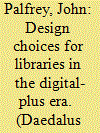

|
|
|
|
|
| Summary/Abstract |
Libraries are more important, not less so, in a digitally networked era. Despite the fact that today's mobile devices feature Google's search box and Apple's Siri to help us find a quick answer to just about any question, we ought to be investing more capital than ever in our public libraries. We need libraries in the digital era to provide a public option to ensure sustained, free, equitable access to knowledge and preservation of our cultural and scientific heritage. In a period when both the analog and digital are useful, the design choices for those building, and reimagining, libraries are many and complex. We ought to design our libraries to meet the near-term possibilities of a networked environment, as well as the long-term requirements of democratic societies and the practice of scholarship. These design choices involve trade-offs and new commitments that may pit future activities against entrenched present-day interests. The essential design choice is between reliance on ever-more efficient interfaces, often developed by commercial outfits, and interfaces that are developed by the library community, engaging the public in coproduction and extending outward via the networked public sphere. The fate of libraries as vibrant institutions with broad public support could turn on the outcome of these design decisions. The challenges facing libraries also inform conversations about the future of other public-facing institutions, such as schools and newspapers, which are important contributors to an informed citizenry and a vital republic.
|
|
|
|
|
|
|
|
|
|
|
|
|
|
|
|
| 4 |
ID:
081459
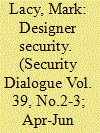

|
|
|
|
|
| Publication |
2008.
|
| Summary/Abstract |
This article suggests that Gilles Deleuze's writings on societies of control provide useful insights on changing configurations of biopower in contemporary societies. However, far from the dystopias depicted in many popular visions of the future, such as the films THX 1138 and Minority Report, societies of control are being shaped by the work of designers, creating the potential for an `ecology of control' that can become `benignly' woven into our lives. MoMA's exhibition SAFE: Design Takes On Risk is a fascinating introduction to designers' responses to risk and insecurity around the planet, along with work that interrogates critically our obsessions with risk, control, and insecurity. SAFE illustrates an emerging synergy between designers and policymakers that makes possible the intensification of control society through products of `communectivity' (such as the ironic `Homeland Security Blanket') and designer security. Indeed, `designing in' protection and `designing out' insecurity are mantras that are increasingly important to contemporary discourses of security in risk-obsessed states. The article expresses the author's concern that discourses of design and security suppress anxiety about the ethico-political consequences of control society, along with broader issues of security politics, at the same time as they install new policy initiatives and `synergies' through the desire to design out insecurity
|
|
|
|
|
|
|
|
|
|
|
|
|
|
|
|
| 5 |
ID:
088039
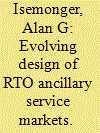

|
|
|
|
|
| Publication |
2009.
|
| Summary/Abstract |
Although the markets for ancillary services at the North American Independent System Operators are often structured in quite different ways there is an emerging set of core design elements that represent a rough consensus as to what the optimal design configuration for ancillary services should be, albeit with some regional variation. This paper looks back at how the design of ancillary services markets has recently evolved to put this development in context. Thereafter it examines the methods by which ancillary services are procured by highlighting the procurement practices at a number of different Independent System Operators, principally those in California, New York, New England, Texas and the PJM Interconnection, in an attempt to tease out the remaining reasons why the ancillary service markets are still so different. This is important as there are many innovations that are not rooted in regional differences but reflect genuine technical advances and economic efficiency gains and can be replicated across other ISOs to produce more efficient designs, greater reliability and lower costs.
|
|
|
|
|
|
|
|
|
|
|
|
|
|
|
|
| 6 |
ID:
170701
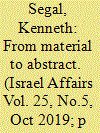

|
|
|
|
|
| Summary/Abstract |
Design anthropology has developed to become an influential sub-discipline occupied with both theoretical and applied knowledge targeted at designers’ real-life challenges. Bearing this in mind, in the last decade we have developed this attitude into a methodology centered around the identification and development of ‘cultural objects’ that can be implemented with insight and understanding within a conventional design process. This methodology isolates and magnifies the cultural aspects of objects and harnesses these to design new hybrid objects that reinterpret and translate cultural values and characteristics into a local context. This paper presents one of the various approaches dealing with the interpretation of philosophic, religious or socio-cultural principles of different cultures through an Israeli designer’s eyes. In this case the re-interpretation of Japanese, African or American cultures of wood and materializing various cultural traits led the students to an intricate and meaningful design process. From the results we recognized two points of significance: understanding that designing and researching through the isolation of a specific material (i.e., wood), the anthropological design process is crystalized and produces profound results that are culturally centered; the second was an insight into how young Israeli designers presented a unique and innovative approach towards contemporary Israeli design through the culture of wood.
|
|
|
|
|
|
|
|
|
|
|
|
|
|
|
|
| 7 |
ID:
101039
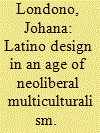

|
|
|
|
|
| Publication |
2010.
|
| Summary/Abstract |
This article considers an emerging shift in Latino cultural politics of design representation and urbanism. To illustrate this shift, I include interviews with designers whose imaginative and geographic locations across the Americas have fostered a global attitude that challenges previous Latino designs that follow nationalist cultural politics of differentiation and are shaped by neoliberal multicultural imperatives. This article serves as an analytical study for scholars interested in understanding the ways in which cultural difference is included in a creative industry that has a large role to play in the configuration, evaluation, and theorization of poor, urban, and ethnic spaces. In particular, this article stimulates a debate about the different modes of incorporating Latino culture in design and generates future discussion on how to achieve more inclusive urban representations.
|
|
|
|
|
|
|
|
|
|
|
|
|
|
|
|
| 8 |
ID:
148950
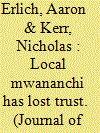

|
|
|
|
|
| Summary/Abstract |
Across African democracies, maintaining popular trust in electoral management bodies (EMBs) is vital to enhancing election integrity and, ultimately, regime legitimacy. However, scholars have largely sidestepped any systematic analysis of how citizens formulate their attitudes towards EMBs and how these attitudes vary over time. To address these gaps in the literature, we focus on Kenyan EMBs, which have experienced fluctuating popular support since the ruinous 2007 elections and subsequent institutional reforms. Using primary election reports and original survey and focus group data, we analyse the sources of Kenyans' trust in EMBs from 1992 onward and probe the 2013 election period deeply. Across time, we find that confidence in EMBs usually collapses after polarised elections, due to perceived problems with the EMB's autonomy and capacity. Following the 2013 elections, Kenyans were also more likely to lose confidence in the EMB if they were affiliated with losing presidential candidates or if they were critical of EMB performance.
|
|
|
|
|
|
|
|
|
|
|
|
|
|
|
|
| 9 |
ID:
151934


|
|
|
| 10 |
ID:
084306
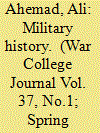

|
|
|
| 11 |
ID:
141402
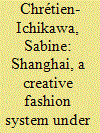

|
|
|
|
|
| Summary/Abstract |
Since the 1990s, Chinese entrepreneurs in the textile and apparel industry have confronted rapid change and increasing pressure stemming from mature foreign entrants and changing local demand. Facing multiple challenges to differentiate and keep a competitive advantage, they are being transformed into creativity-driven organisations. The transition of the Chinese clothing industry into a fashion-creating system entails a specific environment. Not only is it under construction, but its evolution may impact the global fashion economy.
|
|
|
|
|
|
|
|
|
|
|
|
|
|
|
|
| 12 |
ID:
150261
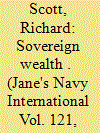

|
|
|
| 13 |
ID:
165356
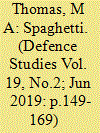

|
|
|
|
|
| Summary/Abstract |
In the mid-2000s, the United States Army was embroiled in counterinsurgency missions in Iraq and Afghanistan that required deeper understanding of local social systems. The Army turned to systems thinking and design thinking to model and understand the world, define problems, and develop approaches to strategic and operational challenges. However, the Army’s approach as expressed in publications and doctrine encourages the development of complicated, unsupported, and unfalsifiable hypotheses. The risk is that the Army will act on incorrect assumptions and develop plans that are fragile.
|
|
|
|
|
|
|
|
|
|
|
|
|
|
|
|
| 14 |
ID:
100222
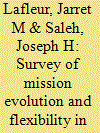

|
|
|
|
|
| Publication |
2010.
|
| Summary/Abstract |
Given the diversity of missions it has accomplished and the myriad of adaptations it has undergone, the US Space Shuttle is widely regarded as a highly flexible space vehicle. With the Shuttle's upcoming 2011 retirement, it is instructive to survey the history of this vehicle's flexibility for the insights it can provide to the design and characterization of flexibility in future space systems. Data are presented on the evolution of mission requirements over time for 120 missions performed by the Space Shuttle over a period of some 27 years. Distinct trends in the time domain - as well as their causes - are identified and discussed, and early manifest plans from 1982 serve as a confirmation that these trends were not originally anticipated. Eight examples are then presented of engineering modifications that allowed the Shuttle to adapt and accommodate these requirement changes. Several additional instances of Shuttle flexibility are explored, such as post-Columbia disaster modification, upgrade programs and derived vehicles, and one case in which flexibility was inhibited by an early design decision.
|
|
|
|
|
|
|
|
|
|
|
|
|
|
|
|
|
|
|
|
|